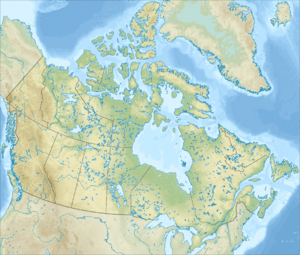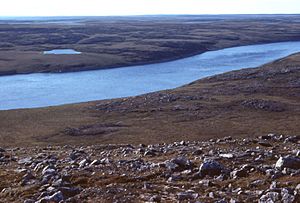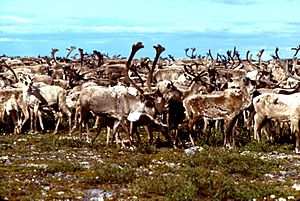Thelon River facts for kids
Quick facts for kids Thelon River |
|
|---|---|
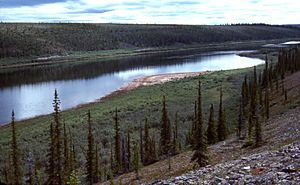
An oasis-like section of the Thelon, below Warden's Grove
|
|
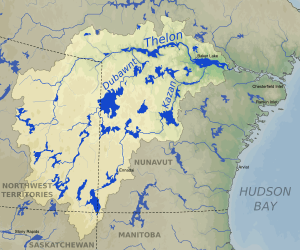
Drainage basin of the Thelon River
|
|
|
Thelon River mouth location
|
|
| Native name | Akilinik |
| Country | Canada |
| Territories | |
| Physical characteristics | |
| Main source | Whitefish Lake. Northwest Territories 62°30′32″N 106°49′17″W / 62.50889°N 106.82139°W |
| River mouth | Baker Lake near Chesterfield Inlet, Kivalliq Region, Nunavut 64°16′30″N 96°4′35″W / 64.27500°N 96.07639°W |
| Length | 900 km (560 mi) |
| Basin features | |
| Basin size | 142,400 km2 (55,000 sq mi) |
| Tributaries |
|
The Thelon River is a long river in northern Canada. Its name, Akilinik, means "on the other side" in the Inuktitut language. The river is about 900 kilometers (560 miles) long. It starts at Whitefish Lake in the Northwest Territories. From there, it flows east into Nunavut, ending at Baker Lake. Eventually, its waters reach Hudson Bay.
Contents
The Thelon River's Geography
The Thelon River is very remote. It is far from most towns and cities. This means the area around it is pure wilderness. Some people call it Canada's most remote river.
The river's drainage basin is a huge area. It covers about 142,400 square kilometers (55,000 square miles). This is the land where all the water flows into the Thelon River.
In its lower parts, the river can be up to a kilometer (0.6 miles) wide. It also widens into several large lakes. These include Beverly Lake, Aberdeen Lake, and Schultz Lake. These lakes are about 100 kilometers (60 miles) upstream from where the river meets Baker Lake.
Animals of the Thelon River
Many amazing animals live around the Thelon River. About 100 moose live there. More than 2,000 muskoxen also make their home in the area.
Every fall and spring, a huge number of barren-ground caribou cross the river. About 300,000 caribou migrate through this region. It's an incredible sight to see!
History of the Thelon River
Early Inhabitants and Explorers
The lands around the Thelon River have been home to the Inuit people for a very long time. This includes groups like the Caribou Inuit and Copper Inuit. They lived in these sparsely populated areas. You can still see signs of their hunting and travel near the river. These include inukshuk stones, which are human-made stone landmarks.
In the 1770s, an English explorer named Samuel Hearne traveled across the Thelon River. He was exploring the northern parts of Canada.
The Thelon Wildlife Sanctuary
In 1926-1927, a sad event happened on the Thelon River. An explorer named John Hornby and two other men died there. They had planned to hunt migrating caribou for food. But they could not find the caribou herd and starved.
Despite this tragedy, Hornby's earlier trips helped create something important. In 1927, the Thelon Game Sanctuary was set up. It was renamed the Thelon Wildlife Sanctuary in 1956. This sanctuary helps protect the animals and nature of the area.
In 1927, a Norwegian explorer and writer named Helge Ingstad also visited the Thelon. He traveled by dog sled to the river's source, Lynx Lake. He went with local native people from Great Slave Lake. He wrote about his adventures in his book, The Land of Feast and Famine.
Visiting the Thelon River
The lower 545 kilometers (339 miles) of the Thelon River are very special. In 1990, this part was named a Canadian Heritage River. This means it's recognized for its natural beauty and history.
There are no roads that lead directly to the river. But many people still visit it every summer. Wilderness campers and canoeists come to explore its remote beauty. It's a great place for an adventure in nature!
See also
 In Spanish: Río Thelon para niños
In Spanish: Río Thelon para niños


